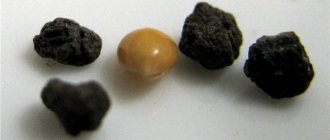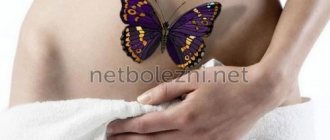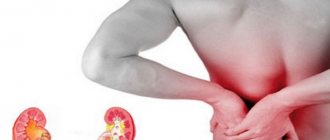Tags:
gastrointestinal diseases, colitis
5/5 — (8 votes)
Colitis is one of the most common pathologies of the gastrointestinal tract. It is an inflammatory disease of the large intestine (or rather, its mucous membrane) with pronounced symptoms , which we will talk about later. The disease can be complicated by inflammatory processes in the stomach and small intestine . It often accompanies some other acute and chronic diseases (influenza, pneumonia, typhoid, mumps, malaria, etc.).
It happens that this disease, due to similar symptoms, is confused with irritable bowel syndrome and for this reason is sometimes misdiagnosed. But since irritable bowel syndrome is not associated with the colon, then, accordingly, it cannot have anything in common with colitis.
Colitis
“Hand in hand” with dysbiosis
There are two forms of colitis - acute and chronic . In both the first and second cases, the infectious component plays a special role in the occurrence and development of the disease - most often bacterial dysentery . It can be triggered by other representatives of pathogenic microflora (for example, coli bacteria, staphylococci, streptococci, bacteria of the Proteus group, etc.). In other words, colitis goes “hand in hand” with dysbacteriosis. Inflammation can also be caused by previous intestinal infections and poor diet, as well as inadequate therapy with various medications. As practice shows, the causes of inflammation are indeed multiple. Let's summarize the main factors :
- infection in the gastrointestinal tract;
- infection with salmonella, staphylococci and other pathogenic microflora due to consumption of poor-quality food;
- the presence of worms (but not in all cases);
- inadequate, monotonous diet (mainly carbohydrates);
- allergies to certain types of food;
- chronic constipation;
- alcohol abuse;
- neglect of personal hygiene rules (for example, touching food with dirty hands);
- long-term use of certain antibiotics that can provoke dysbacteriosis;
- intoxication (poisoning with lead, arsenic and its preparations, mushrooms);
- nervous and emotional tension, stress.
Colitis ulcerosa - all Stages
Diagnostics
When the first signs of a disorder appear, you should contact a highly specialized specialist - a gastroenterologist. At the first stage of diagnosis, laboratory tests are performed, gastroscopy and other endoscopic examination methods are prescribed. If the patient is prohibited from undergoing invasive diagnostics (with the penetration of endoscopic instruments), no less informative and safe MRI technology is used.
During the scanning process, a coloring agent is introduced into the intestinal cavities, which highlights the relief of the inner surface of the mucous membrane. The images show the areas where intestinal inflammation occurs. In this case, the patient does not experience pain from the procedure, since magnetic resonance imaging of internal structures takes place “remotely”. The person simply lies inside the device, and the scanners take layer-by-layer photographic images of the area being studied.
Acute colitis: causes, symptoms, treatment
This form of the disease is caused by staphylococci, streptococci, salmonella and dysentery microorganisms . It also occurs as a result of common infections (influenza, acute respiratory viral infections, acute respiratory infections, measles), allergies or intolerance to certain medications (usually antibiotics). Often, with acute colitis, the stomach and small intestine become inflamed. As a result, according to the “domino principle,” the normal functioning of other organs of the gastrointestinal tract is disrupted. Depending on the nature of the damage to the large intestine, doctors diagnose several types of acute colitis, namely: catarrhal, ulcerative, erosive, and sometimes fibrinous .
The main symptoms include:
- cramping abdominal pain and bloating;
- the presence of mucus and blood in the stool;
- diarrhea (diarrhea).
The disease usually begins suddenly and, as a rule, with a bowel disorder. Patients feel sick and have no appetite . I am tormented by vomiting and constantly thirsty. They complain of general weakness, a sharp deterioration in health and fever . However, vomiting and diarrhea have their advantages: doctors attribute these manifestations to protective reactions. That is, in this way the body tries to get rid of the poisons that have gotten inside.
Symptoms of acute colitis may depend on the location of the inflammation. For example, when the left half of the colon is affected, pain manifests itself most sharply. Before defecation, they usually intensify and radiate to the perineum and sacrum. Stools are very frequent, up to 20 times a day (sometimes more). The stool has an uneven consistency: dense masses “float” in blood or copious mucus. The areas of the descending and sigmoid colon are painful to palpation. This is where rumbling and splashing sounds are detected.
Colitis
This symptomatology can manifest itself over several weeks and, if left untreated, the acute form usually becomes chronic. Such undesirable developments can be prevented with timely assistance.
Thus, treatment of acute colitis includes the following measures :
- drinking plenty of fluids to replenish fluid losses in the body . It is recommended to drink a specially prepared solution that is well absorbed by the intestines: add a teaspoon of salt and seven to eight teaspoons of sugar per liter of warm boiled water. You can drink mineral water and weak tea, but coffee is undesirable because it affects intestinal motility and increases diarrhea. In some severe cases, fluid is administered intravenously.
- therapeutic fasting for one to two days. Then a strict diet is indicated until the symptoms of the disease completely disappear.
- taking activated carbon. Prescribed for the absorption of toxins in the large intestine.
- taking enzyme preparations, enveloping and adsorbent substances.
- physiotherapeutic treatment.
Diagnosis and treatment of enteropathies
Etiology The etiology of most enteropathies is quite well known [1]. Examples include gluten-sensitive celiac disease (GC), enteropathies caused by bacteria, viruses, fungi and parasites, medications (nonsteroidal anti-inflammatory drugs (NSAIDs), antibiotics), and food allergens. Enteropathy can be caused by physical factors (radiation, toxins), abnormalities in the development of arteriovenous and lymphatic vessels (malformations), gastrectomy and chronic diseases of the blood vessels, blood, kidneys, connective tissue, endocrine and immune systems. A correctly established nosological diagnosis for the diseases of the small intestine listed above makes it possible to achieve recovery with restoration of the structure of the intestine or clinical and morphological remission, subject to the exclusion of the influence of the etiological factor and optimal treatment of the underlying disease. The most severe and prognostically unfavorable are enteropathies, the cause of which cannot be determined. These include autoimmune enteropathy with the formation of antibodies to enterocytes, collagen sprue, refractory sprue, hypogammaglobulinemic sprue, granulomatous regional enteritis (Crohn's disease), idiopathic non-granulomatous ileitis, eosinophilic gastroenteritis, enteropathy developing in graft-versus-host syndrome, as well as enteropathy with loss (exudation) of protein into the intestinal lumen. Exudative enteropathy is not a separate nosological form. It can be primary (due to developmental abnormalities) and secondary lymphangiectasia. Secondary forms arise as a result of mechanical or functional blockade of the intestinal lymphatic system of an inflammatory or tumor nature. Exudative enteropathy syndrome develops with Whipple's disease, vascular diseases, right ventricular failure of various etiologies. Pathomorphology The pathomorphology of most enteropathies does not have strictly pathognomonic nosological criteria. The exceptions are celiac disease, Whipple's disease, hypogammaglobulinemic sprue, collagenous sprue, Crohn's disease, in which the pathohistological picture allows an accurate nosological diagnosis to be established. Celiac disease is characterized by villous atrophy, deepening of the crypts, and lymphoplasmacytic infiltration of the lamina propria and enterocytes. In hypogammaglobulinemic sprue, the structure of the SOTK is similar to celiac disease, but differs in the almost complete absence of plasma cells in the infiltrate. In collagen sprue, a layer of collagen forms under the basement membrane of enterocytes. Whipple's disease is characterized by the presence of RAS-positive macrophages in the lamina propria of the TAC. Crohn's disease is characterized by the development of granulomatous inflammation of the intestinal wall with the presence of granulomas containing Pirogov-Langhans giant cells (Fig. 1), which can only be detected in the surgical material due to their localization in the submucosal layer of the intestine. With other types of enteropathies, pathohistological changes are less specific or are not at all specific for a specific form (infectious, radiation, etc.) of enteropathy. Many enteropathies are characterized by the formation of small intestinal ulcers. An example is enteropathies associated with arteriovenous and lymphatic malformations of the STC. When these vascular formations are damaged (ulcerated), occult bleeding appears. In rare cases, ulcerative jejunitis may be a manifestation of nongranulomatous chronic enterocolitis of unknown etiology. Autoimmune enteropathy is a life-threatening disease mainly in young children and almost exclusively in men. It is characterized by the formation of antibodies to the body's own enterocytes. A biopsy of the CVD shows partial or complete villous atrophy and crypt hyperplasia, infiltration of mononuclear cells into the lamina propria and surface epithelium. Some of these patients have immunoglobulin (IG) A deficiency. Autoimmune enteropathy often has a refractory course with a poor prognosis. Clinical features The clinical picture of enteropathy is generally characterized by a combination of chronic diarrhea and malabsorption syndrome. Pain syndrome is absent or insignificant, but if the patency of the small intestine is impaired, it can be the leading one in the clinical picture. Blood tests often reveal microcytic or B12-deficiency anemia, which is caused by decreased absorption of iron, vitamin B12 and folic acid. Leukocytosis, accelerated ESR, increased levels of C-reactive protein (CRP), fecal calprotectin (FCP) indicate the inflammatory origin of the disease of the small intestine. A decrease in the blood serum content of potassium, calcium, magnesium and chlorine ions, protein, and cholesterol indicates poor absorption in the small intestine, and a decrease in IG is one of the signs of hypogammaglobulinemic sprue. Chronic non-granulomatous idiopathic enteritis occurs with abdominal pain, anorexia, weight loss, fever, diarrhea, steatorrhea, hypoalbuminemia and hypoproteinemia. Inflammatory changes in the somatic tissue can be combined with nonspecific duodenojejunal ulcers. The main symptom of enteropathy associated with arteriovenous malformations of the arteriovenous angioectasia may be bleeding, the source of which is damage (ulceration) of arteriovenous angioectasia. With lymphangiectasias, excessive loss of protein into the intestinal lumen occurs. Exudative enteropathy can also appear in patients with HC. If hypoproteinemia and hypoproteinemic edema progress against the background of strict adherence to a gluten-free diet (AGD) and parenteral infusion of protein drugs, then the development of enteropathy associated with T-cell lymphoma (AETL) can be highly likely. The diagnosis of AETL is confirmed by a histochemical study of SOTK. If a progressive deterioration of the condition occurs in a patient with newly diagnosed HC and does not improve with adherence to AHD, then a differential diagnosis is required with both lymphoma and refractory and unclassified forms of celiac disease. Diagnosis The nosological characteristics of enteropathies have improved with the improvement of immunological, endoscopic and radiological methods for diagnosing the small intestine [2]. Diagram 1 shows the capabilities of each of them. The leading role in the differential diagnosis of HC with enteropathies not associated with celiac disease is played by a biopsy of the cellular tissue. Diagnosis can be difficult because... Some patients with celiac disease may not have antitissue transglutaminase antibodies (ATtTG) at the time of diagnosis [3], and recovery of TTG may be very slow despite strict adherence to ADT [4]. Changes in STC, similar to celiac disease, can also occur in other diseases. For example, similar atrophy of the mucous membrane of the proximal duodenum is observed in some patients with acid-related diseases under the influence of the peptic factor. Differential diagnosis in these cases is helped by negative results of immunological studies for ATtTG and antibodies to diamidated gliadin peptide (ADPG) [5]. Villous atrophy, reminiscent of that seen in HC, can also be seen in patients with common variable immunodeficiency, especially in the presence of symptoms of malabsorption [6]. In this case, hypogammaglobulinemic sprue should be excluded [1]. Inflammatory bowel disease (IBD) is the second most common cause of villous atrophy after HC [7]. The response to AGD is a test for celiac disease, although improvement may also be observed in non-gluten enteropathy [8]. Therefore, this symptom should be assessed with caution as a diagnostic sign. In patients with a slight increase in ATTTG and subepithelial deposits (SED) IHA ATTTG, it is recommended to test for HLADQ2/DQ8. Diagnosis of celiac disease using the HLA-DQ2 and HLA-DQ8 genotypes is based on the close relationship between HC and certain HLA types: more than 95% of patients are DQ2-positive, and almost all the rest are DQ8-positive. The most common non-gluten enteropathy is autoimmune enteropathy. It resembles celiac disease histologically and is clinically similar to other diseases of the immune system. Immune enteropathy can cause severe malabsorption syndrome. The true epidemiology and pathogenesis of this disease are unknown and require further study. The diagnosis of autoimmune enteropathy is warranted when the patient does not respond to AHD therapy with an atypical clinical picture of HC. Diagnosis is aided by initial results of serological tests for celiac disease, determination of antibodies to enterocytes, HLA DQ2/DQ8 testing, repeat biopsy and comparison of the histological picture with a previously performed biopsy. Differential diagnosis of enteropathies Modern endoscopic methods, although they have increased the level of diagnosis of diseases of the small intestine, have not solved many problems. This is due to the fact that the pathomorphological manifestations of enteropathies have much in common and in most cases differ only in the depth and extent of damage to the STC. Characteristic signs of enteropathy are changes in the mucous membrane, the shape and height of the folds, the lumen of the intestine, its tone, as well as erosion and ulcers. All these signs are not specific to a particular nosological form. Thus, the SOTC aphthae shown in Figure 2, found in a patient with granulomatous Crohn's ileitis, can also be observed in patients with NSAID-associated enteropathy. More accurate data for nosological diagnosis can be obtained from histological examination of biopsy specimens, through which it is possible to establish celiac disease, Whipple's disease, and hypogammaglobulinemic sprue. The difficulties of differential diagnosis of enteropathies can be judged from the following clinical observation. Patient T., 45 years old, was unsuccessfully treated for 2 years for constant muscle pain, the cause of which could not be determined. The muscle pain became more and more severe, and the patient lost his ability to work. Due to the failure of treatment, in 2004 he was sent to the Central Research Institute of Gastroenterology. In the intestinal pathology department of the institute, the patient underwent deep jeunoscopy and video capsule enteroscopy. Capsule video endoscopy (Fig. 3) and deep endoscopy (Fig. 4) revealed inflammatory changes in the small intestine with erosions and slit-like ulcers characteristic of Crohn's disease. A diagnosis was made: granulomatous jeunitis (Crohn's disease) with extraintestinal manifestations in the form of severe myalgia. Treatment with mesalazine and prednisolone was prescribed. Recovery has come. Nevertheless, the autoimmune pathogenesis of myalgia and the absence of relapses of the disease in subsequent years do not completely exclude the possibility of autoimmune enteropathy, which occurred without clinical intestinal symptoms.
Ultrasound and X-ray methods of examining the small intestine also help detect signs of enteropathy, but at a more advanced stage, when deep ulcers, narrowings and fistulas appear, especially characteristic of granulomatous inflammation in Crohn's disease. The use of computed tomography (CT), multislice computed tomography (MSCT) and magnetic resonance imaging (MRI), especially with contrast examination of the small intestine, has brought the x-ray method to a new level, because It became possible to visualize the entire intestinal wall and assess the extent and depth of the lesion. Scheme 2 shows the algorithm for the differential diagnosis of enteropathy.
Treatment Table 2 shows the principles of therapy for enteropathy. Treatment of enteropathies can be etiotropic, pathogenetic and symptomatic. Etiotropic treatment is applicable to diseases with a known etiology. Patients with HC are prescribed lifelong AGD. For Whipple's disease, long-term (up to 1 year or more) antibacterial therapy is indicated; for tropical sprue and infectious gastroenteritis, the usual course of treatment with an antibiotic or intestinal antiseptic is indicated. In patients with allergic gastroenteritis, recovery is facilitated by the exclusion of food allergens from the diet and antihistamines. In other cases, a diet is prescribed that is poor in long-chain triglycerides and enriched in medium-chain triglycerides, which are contained in food mixtures intended for enteral nutrition (Nutrizon, Portagen, Entrithione, Isocal, etc.). The diet should contain an increased amount of protein (up to 130 g/day). The main method of eliminating hypoproteinemia is long-term intravenous administration of protein-containing solutions, primarily albumin and γ-globulin. All patients are prescribed calcium and iron supplements. Twice a year, all patients with malabsorption are prescribed courses of treatment with vitamins. Pathogenetic agents are used to treat enteropathies of unknown etiology (Crohn's disease, autoimmune enteropathy, collagen sprue, refractory sprue, hypogammaglobulinemic sprue). They are aimed at eliminating the inflammatory process. For Crohn's disease and other autoimmune diseases, systemic and topical corticosteroids, 5-aminosalicylic acid (5-ASA) preparations, immunosuppressants, and tumor necrosis factor-α inhibitors are used. TsNIIG successfully uses allogeneic mesenchymal stem stromal cells for IBD therapy [9]. Symptomatic therapy is used in the treatment of all enteropathies. To improve intestinal digestion, pancreatic enzymes are prescribed. One of them is Hermital. Ermital contains standard highly active pancreatin obtained from the pig pancreas in the form of microtablets that are resistant to gastric juice. The enzymes included in the composition: lipase, alpha-amylase, trypsin, chymotrypsin help break down proteins into amino acids, fats into glycerol and fatty acids, starch into dextrins and monosaccharides, and normalize digestive processes. Dosage 10,000 units: 1 capsule with gastric acid-resistant microtablets contains 87.28–112.9 mg of pancreatin from the pig pancreas, which corresponds to the activity of lipase 10,000 units, amylase 9,000 units, protease 500 units. Dosage 25,000 units: 1 capsule with gastric acid-resistant microtablets contains 218.2–282.4 mg of pancreatin from the pig pancreas, which corresponds to the activity of lipase 25,000 units, amylase 22,500 units, protease 1,250 units. Dosage 36,000 IU: 1 capsule with gastric juice-resistant microtablets contains 272.02–316.68 mg of pancreatin from the pig pancreas, which corresponds to the activity of lipase 36,000 IU, amylase 18,000 IU, protease 1,200 IU. Ermital is swallowed whole during meals, washed down with plenty of liquid (water, juices). Crushing or chewing microtablets or adding them to food with pH<5.5 leads to the destruction of their shell, which protects against the action of gastric juice. The recommended dose is 2–4 caps. Ermital drug 10,000 units, or 1–2 caps. 25,000 units, or 1 capsule. 36,000 units with each meal. In order to reduce fermentation and putrefactive processes in the intestines, antidiarrheal agents are prescribed: enterosorbents, regulators of motility (prokinetics) and intestinal secretion (somatostatin), as well as enteroprotectors that stimulate reparative processes in the somatic system [10]. Treatment regimen for patients with enteropathy: first, drugs are prescribed to suppress bacterial overgrowth syndrome, intestinal antiseptics are prescribed for 6–7 days, then probiotics and prebiotics are metabolic products of normal microorganisms and substrates that help maintain the vital activity of beneficial microbes. Supplementing the diet with prebiotics increases the concentration of short-chain fatty acids in the intestine and thereby improves its anatomical structure and motor-evacuation function. Prebiotics can be delivered to the body as synbiotics, which include live probiotic bacteria and complex supplements used by the microbiota as a source of energy and growth. Baktistatin is interesting, combining the properties of a probiotic, prebiotic and enterosorbent, which is successfully used for this pathology. Bactistatin is a combination of sterilized cultural liquid of Bacillus subtilis 3: bacteriocins, lysozyme, catalases that suppress the growth of opportunistic microorganisms (probiotic component), zeolite (sorbent) and soy flour (prebiotic component). Antibiotic-like substances and enzymes produced by the bacteria Bacillus subtilis stimulate the growth and activity of their own symbiont microflora. Amino acids, antigens, polypeptides and other biologically active substances produced during fermentation by bacteria have an immunomodulatory effect due to stimulation of the synthesis of endogenous interferon and activation of macrophages. Thus, the prebiotic compounds in Baktistatin ensure the restoration of normal intestinal microflora, increase the body’s nonspecific resistance, and promote complete digestion. Zeolite is a natural sorbent with ion-exchange properties, exhibiting sorption properties mainly in relation to compounds with low molecular weight (methane, hydrogen sulfide, ammonia and other toxic substances). Zeolite improves digestive processes by increasing the area of biochemical reactions in the intestines, sorption of low molecular weight metabolites and normalizing the state of intestinal microflora, normalizes peristalsis, accelerating the movement of intestinal contents through the digestive tract. Soy flour hydrolyzate is a natural source of complete protein and amino acids, providing the most favorable conditions for the non-competitive growth of normal intestinal microflora and restoration of the microbial landscape of the body. It has been established that Baktistatin is an effective means for correcting the intraluminal intestinal environment, which is expressed by a change in the profile of microflora metabolites, in particular short-chain fatty acids, and the values of the anaerobic index, which characterizes the redox potential of the intraluminal environment [11]. Bactistatin is prescribed orally, 1–2 caps. 2 times a day with meals. Duration of treatment – 2–3 weeks. Conclusion Nosological diagnosis of enteropathies is one of the most difficult tasks in the clinic of internal diseases. Particularly difficult to recognize are forms of celiac disease that are insensitive to gluten (refractory, collagenous and hypogammaglobulinemic sprue, autoimmune enteropathy). Significant difficulties arise in the differential diagnosis of enteropathies with erosive and ulcerative lesions of the somatic tissue. Nevertheless, existing laboratory and instrumental research methods make it possible to establish the cause of enteropathy in a significant number of patients, prescribe etiotropic treatment and achieve recovery.
Literature 1. Parfenov A.I. Enterology: a guide for doctors. Ed. 2nd M.: MIA, 2009. 2. Shcherbakov P.L. Advances of endoscopy in the diagnosis and treatment of diseases of the small intestine // Ter. arch. 2013. No. 85 (2). pp. 93–95. 3. Leffler DA, Schuppan D. Update on serologic testing in celiac disease // Am J Gastroenterol. 2010. Vol. 105. R. 2520–2524. 4. Rubio-Tapia A, Rahim MW, See JA et al. Mucosal recovery and mortality in adults with celiac disease after treatment with a gluten-free diet // Am J Gastroenterol. 2010. Vol. 105. R. 1412–1420. 5. Gudkova R.B., Parfenov A.I., Sabelnikova E.A. The significance of antibodies to diamidated gliadin peptide in adult celiac disease: Sat. abstracts of the XXXIX session of the TsNIIG “Multidisciplinary approach to gastroenterological problems.” M., 2013. pp. 98-99. 6. Malamut G., Verkarre V., Suarez F. et al. The enteropathy associated with common variable immunodeficiency: the delineated frontiers with celiac disease // Am J Gastroenterol. 2010. Vol. 105. R. 2262–2275. 7. Ludvigsson JF, Brandt L, Montgomery SM et al. Validation study of villous atrophy and small intestinal inflammation in Swedish biopsy registers // BMC Gastroenterol. 2009. Vol. 9. R. 19. 8. Biesiekierski JR, Newnham ED, Irving PM et al. Gluten causes gastrointestinal symptoms in subjects without celiac disease: a double-blind randomized placebo-controlled trial // Am J Gastroenterol. 2011. Vol. 106. R. 508–514. 9. Knyazev O.V., Ruchkina I.N., Parfenov A.I. et al. Efficacy of allogeneic bone marrow mesenchymal stromal cells in patients with refractory Crohn's disease. 5 years of observation: Sat. abstracts of the XXXIX session of the TsNIIG “Multidisciplinary approach to gastroenterological problems.” M., 2013. pp. 98–99. 10. Parfenov A.I., Ruchkina I.N. Enterosan is a promising drug for the treatment of patients with post-infectious irritable bowel syndrome // Experiment. and wedge. gastroenterology. 2011. No. 3. pp. 102–104. 11. Ardatskaya M.D., Minushkin O.N. Bacterial overgrowth syndrome: definition, modern approaches to diagnosis and therapeutic correction. Consilium medicum (Gastroenterology application) 2012; 2: 72–76.
About the causes, symptoms and treatment of chronic colitis
Chronic colitis is a disease where the leading provoking factor is the presence of infection in the gastrointestinal tract . Its manifestations are “many-faced”. It occurs in the form of periodic exacerbations. The latter occur as a result of consuming foods that irritate the colon; manifestations of allergies; long-term use of various antibiotics; general fatigue.
The main symptoms of chronic colitis include:
- cramping pain in the abdomen (but does not always occur, more often accompanying the act of defecation);
- diarrhea alternating with constipation;
- secretion of mucus (in some cases mixed with blood);
- lack of appetite;
- nausea, belching of air, unpleasant taste in the mouth;
- a feeling of heaviness and distension in the abdomen (as a result of flatulence);
- a feeling of pressure in the epigastric region (often manifests itself in connection with gastritis);
- deterioration in general health (weakness, poor sleep, headaches, irritability, depressed mood).
Chronic colitis sometimes occurs as a consequence of functional disorders of the intestines (for example, with prolonged constipation). The causes also include dyskinesia (impaired motor function), which is associated with reflex effects from the gallbladder, bladder, prostate and other organs.
The basis for the treatment of chronic colitis (regardless of its etiology) is a dietary regimen. Drug therapy is effective only in cases where the cause is clearly established. When constructing a diet, the nature of dyspepsia (putrefactive or fermentative) and the state of the pancreas and its secretory function are taken into account . A too strict diet is not needed, as there is a risk of exhaustion and the development of hypovitaminosis, which will only complicate the course of colitis.
Strict dietary restrictions are allowed only during periods of exacerbation of the disease . Then foods that irritate the intestines both mechanically and chemically are excluded . Food is consumed boiled or pureed. Meals are split (6-7 times during the day). The consumption of table salt is limited (up to 8-10 g). Allowed: non-rich meat broth, steamed cutlets from lean meats, boiled fish (also low-fat), non-acidic cottage cheese, water porridge, juices, jelly. There is a strict taboo on black bread, spicy dishes, and various smoked foods. It is undesirable to eat lard and pork, goose meat and milk, sour cream, eggs, canned food, etc. Patients prone to diarrhea should not eat cold food, and the same applies to drinking.
If chronic colitis is accompanied by constipation, then the diet must include foods to stimulate intestinal function: minced meat, boiled vegetables and fruits.
Causes of intestinal inflammation
There are several groups of factors leading to the development of pathology. The most common of them are various infectious lesions caused by viral, bacteriological or protozoan cellular pathogens. Helminth infection is also common.
With a previously diagnosed autoimmune disease, there is a suspicion of the production of antibodies aimed at destroying one’s own cells that make up the mucous membrane. A congenital predisposition to insufficient production of enzymes necessary for digestion is possible. An improperly balanced diet, abuse of fried and spicy foods lead to changes in the composition of the microflora.
There are isolated cases where temporary intestinal inflammation occurs. During pregnancy, women's metabolic processes change, the immune system weakens so that the body can more easily tolerate a “foreign” body in the form of a fetus.
Prevention of colitis
They say that disease is easier to prevent than to treat. Therefore, preventive measures are very important.
Prevention of acute colitis consists of following the norms of proper nutrition and a healthy lifestyle, maintaining hygiene and sanitary rules.
In the prevention of chronic colitis, special attention is paid to the prevention and timely treatment of acute colitis and especially dysentery. A large role in the prevention of diseases of the gastrointestinal tract is played by high-quality nutrition and, accordingly, maintaining the intestinal microflora in a healthy state . Not to mention the good condition of the chewing apparatus and strengthening of the nervous system.








